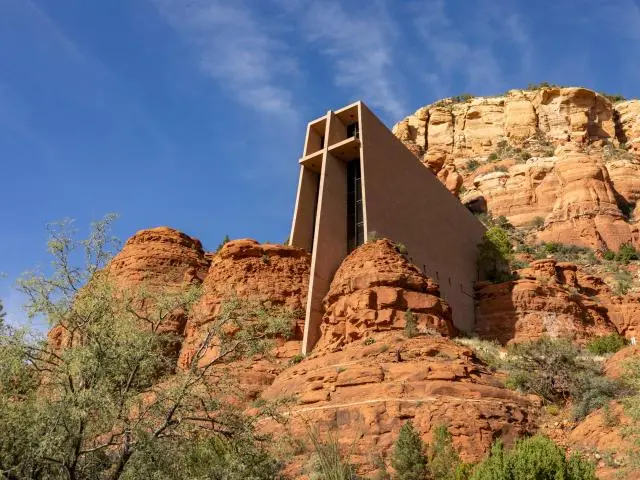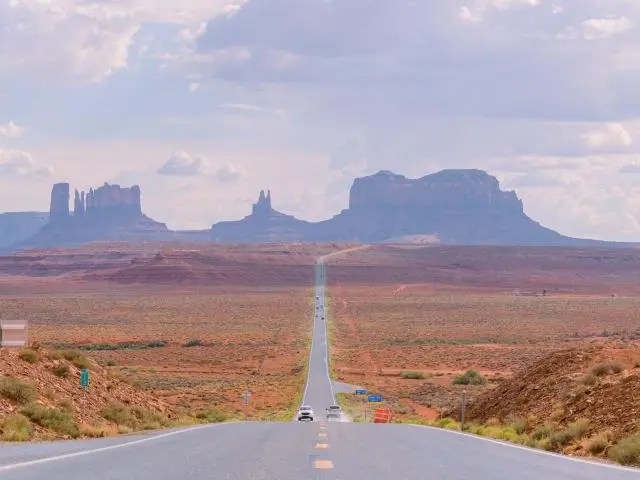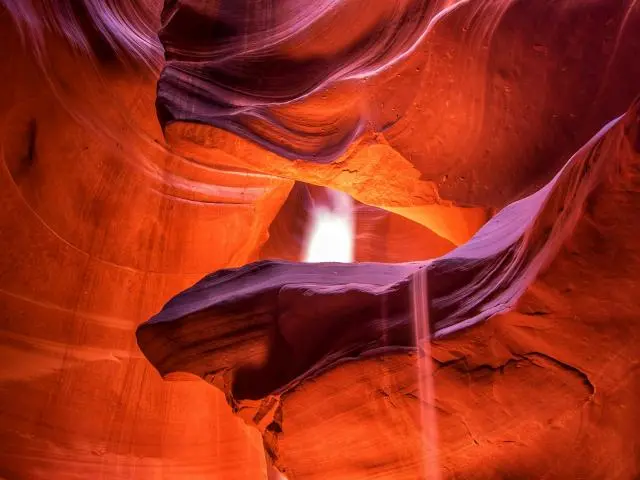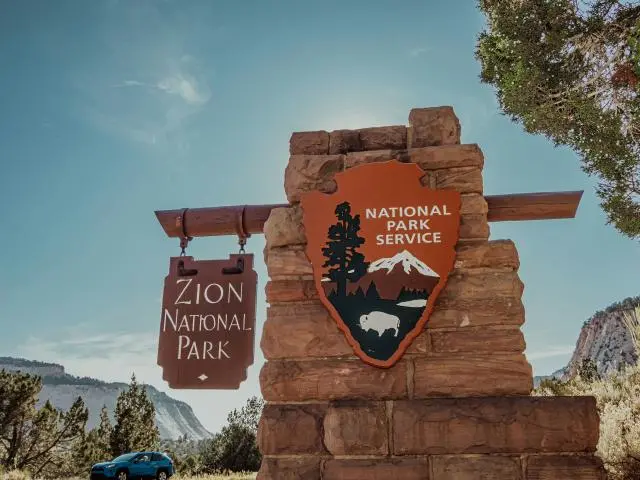Day 1 Las Vegas - Sedona - Page (352 miles)
Day 2 Page - Monument Valley Tribal Park - Page (146 miles)
Day 3 Antelope Canyon-Valley of Fire-Las Vegas (237 miles)
Day 4 Las Vegas
Day 5 Las Vegas - Grand Canyon - Page (379 miles)
Day 6 Page - Antelope Canyon - Bryce Canyon National Park - Kanab (115 miles)
Day 7 Kanab - Zion National Park - Las Vegas (199 miles)
Day 1:
Las Vegas - Sedona - Page (352 miles)
We will begin our day by leaving Las Vegas and traversing the Mojave Desert along historic Route 66 before we arrive in Sedona, AZ. Then, we will drive through breathtaking Oak Creek Canyon, stopping for photos along the way. Back in Sedona, we will enjoy a lunch break at a location where we will be able to browse authentic Indian arts and crafts stores and other unique galleries and boutiques. After our break, we will head into the surrounding desert to visit the Chapel of the Holy Cross (self-guided visit using local shuttle service) to see panoramic vies of the red rock formations around Sedona. In the late afternoon, we will make our way to Page for the evening.
-
Sedona, AZ
This small city in the Verde Valley region of Arizona attracts visitors from all over with its gorgeous red sandstone rock formations. It is a popular place for outdoor recreational activities like hiking, biking, and mountain climbing.
Route 66
Called the "Main Street of America," this highway stretching from Chicago, IL to Los Angeles, CA was one of the first highways built in America as part of the US Highway System. It was established in 1926.
Chapel of the Holy Cross
This church in Sedona was built over 18 months at a cost of $300,000 in 1956. Its design was inspired by the local rancher and sculptor Marguerite Brunswig Staude.
Opening Hours: 9:00am - 6:00pm
Oak Creek Canyon
Called the little cousin of the Grand Canyon, this 12-mile canyon in Arizona is a popular tourist spot. It offers swimming and fishing areas in addition to hiking, picnic area, and campgrounds.
-
Page, AZ
Page is a city in Coconino County, Arizona, United States, near the Glen Canyon Dam and Lake Powell. Page was founded in 1957 as a housing community for workers and their families during the construction of nearby Glen Canyon Dam on the Colorado River.
Day 2:
Page - Monument Valley Tribal Park - Page (146 miles)
We start the day heading into Monument Valley, taking a Jeep Tour led by a Navajo guide. The tour will
take you down into the valley and you will experience firsthand
why the Navajo call this land “like no other place on earth”. Next,
we head into to the mighty Colorado River, for a visit to Horseshoe Bend.
-
Monument Valley Tribal Park, UT
Monument Valley in Arizona is home to exquisite desert scenery and immense geological formations that can be seen for miles around. The valley lies within the range of the Navajo Nation Reservation and is accessible from U.S. Highway 163.

Monument Valley Jeep Tour
This tour is an amazing way to see the wide expanses of Monument Valley, in the safety of an all-terrain Jeep. For about an hour and a half, you will explore off road.
-
Page, AZ
Page is a city in Coconino County, Arizona, United States, near the Glen Canyon Dam and Lake Powell. Page was founded in 1957 as a housing community for workers and their families during the construction of nearby Glen Canyon Dam on the Colorado River.
Horseshoe Bend
Horseshoe Bend, located within the Glen Canyon National Recreation Area about 5 miles downriver from Lake Powell, is a sharp turn in the Colorado River that formed from erosion over the course of millions of years.
Duration: Approx. 1 Hour
Day 3:
Antelope Canyon-Valley of Fire-Las Vegas (237 miles)
Today, we will begin where "the water runs through the rocks," according to the local Navajo folklore. We will tour the lower Antelope Canyon before making our way back to Las Vegas. Along the way, we will stop for lunch before visiting the Valley of Fire. In the early evening, we will arrive in Las Vegas.
-
Antelope Canyon, AZ
The most popular slot canyon in the American Southwest is Antelope Canyon, a sandstone formation formed by flood and rainwater. The canyon is located on a Navajo reservation, and has been made a Navajo Tribal Park.
Lower Antelope Canyon
The lower canyon is in the shape of a "V" and Longer, shallower than the Upper Antelope. Lighting is better in the early hours and late morning. It draws a considerable number of photographers.
-
Valley of Fire State Park, NV
This park in the southeasternmost regions of Nevada gets its name from the way sunlight looks when reflected off the red sandstone formations. The brilliant dunes and rocks are more than 150 million years old.
Day 4:
Las Vegas
We will spend the entirety of today living it up in the wild world of Las Vegas, where we can visit outlet malls for some discount shopping, try our luck at one of the many casinos, enjoy food at a delicious restaurant, see one of the high-energy performance shows, and much, much more!
-
Las Vegas, NV
Las Vegas is known as the "Entertainment Capital of the World" for a good reason-- casinos and hotels line its streets, and visitors can gamble, see shows, and shop at virtually any hour of the day or night.
Day 5:
Las Vegas - Grand Canyon - Page (379 miles)
Breakfast: Included (Continental)|Lunch: Excluded|Dinner: Excluded
We start the day traveling South East through the desert and the through the Navajo Indian reservation before we come to the South Bank of "One of the 7 wonders of the world" the Grand Canyon. After lunch we continue along the canyon east stopping at some of the many Indian market places to browse the handmade arts and crafts. After enjoying the Indian market we head to the Page and Lake Powell area for the evening.
-
Grand Canyon, AZ
Considered one of the seven natural wonders of the world, the Grand Canyon was carved over 17 million years by the Colorado River. This breathtaking, 18-mile-long canyon has been stunning visitors for hundreds of years.
Grand Canyon South Rim
More than five million visitors per year come to the South Rim of the Grand Canyon to witness the majesty of this natural wonder. The Grand Canyon Village makes this the most tourist-friendly of the canyon's rims.
Day 6:
Page - Antelope Canyon - Bryce Canyon National Park - Kanab (115 miles)
Breakfast: Included (Continental)|Lunch: Excluded|Dinner: Excluded
We start the tour at Lower Antelope Canyon and visit the spectacular dunes created by the wind, water and sand. After that we will visit Bryce Canyon National Park, home of amazing rock formations. We will stay here to see the magnificent sunset. For the night, we will make our way to either Kanab, UT, or Cedar City, UT.
-
Antelope Canyon, AZ
The most popular slot canyon in the American Southwest is Antelope Canyon, a sandstone formation formed by flood and rainwater. The canyon is located on a Navajo reservation, and has been made a Navajo Tribal Park.
Admission (Optional): Adult $33; Child $25
Lower Antelope Canyon
The lower canyon is in the shape of a "V" and Longer, shallower than the Upper Antelope. Lighting is better in the early hours and late morning. It draws a considerable number of photographers.
-
Bryce Canyon National Park, UT
Marked by unique desert geological formations - horseshoe amphitheaters and "hoodoos," tall, thin rock spires jutting from the arid ground - Bryce Canyon National Park in southern Utah is a popular destination for desert photographers.
Day 7:
Kanab - Zion National Park - Las Vegas (199 miles)
Breakfast: Included (Continental)|Lunch: Excluded|Dinner: Excluded
Today we will visit Zion National Park before returning to Las Vegas. See "Departure and Return Details" for more information.
-
Zion National Park, UT
Zion Canyon may not be as famous as the nearby Grand Canyon, but it is certainly just as picturesque, with hoodoo spires rising from the ground, red-orange canyon walls towering around, and perhaps more vegetation than its "grand" counterpart.


















 8-Day Yellowstone, Mount Rushmore, Grand Teton, Antelope Canyo...
8-Day Yellowstone, Mount Rushmore, Grand Teton, Antelope Canyo...
 7-Day Yellowstone National Park, Antelope Canyon, Monument Val...
7-Day Yellowstone National Park, Antelope Canyon, Monument Val...
 8-Day Yellowstone Park, Grand Canyon, Antelope Canyon Tour fro...
8-Day Yellowstone Park, Grand Canyon, Antelope Canyon Tour fro...
 6-Day Grand Canyon, Antelope Canyon, Zion and Theme Park Tour...
6-Day Grand Canyon, Antelope Canyon, Zion and Theme Park Tour...
 7-Day Grand Canyon, Antelope Canyon, Zion and Theme Park Tour...
7-Day Grand Canyon, Antelope Canyon, Zion and Theme Park Tour...